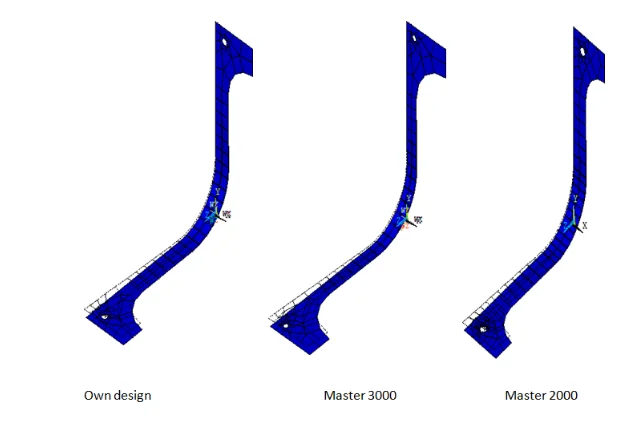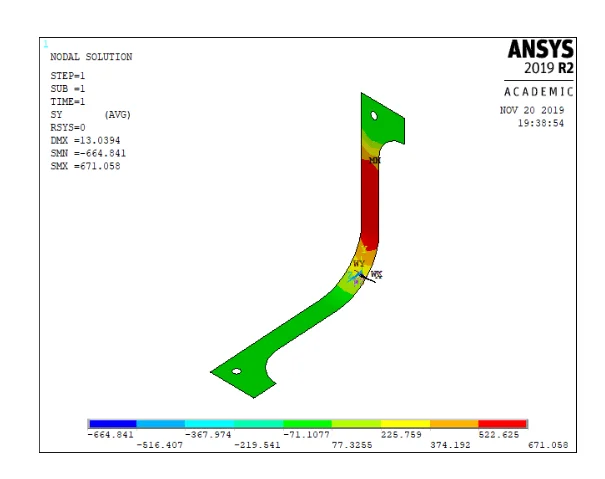Evaluating ANSYS for Bracket Simulation
Introduction
The study aims at evaluating the utilisation of ANSYS Mechanical simulation software through discussing the simulation of a right-angle bracket. finite-element process ANSYS system is today’s critical component and process where the Multi-purpose orientation programs, hardware autonomy (from personal computers to workstations and supercomputers), full integration with leading manufacturers of CAD / CAM / CAE systems, spline-based geometric modelling software (NURBS technology), and a "warm" GUI are effective to develop multi-purpose orientation programs. By applying convergence tests, it is possible to identify the accuracy of the simulation (Naik et al., 2018). The programmability capabilities of the ANSYS Mechanical APDL are efficient where it is a simulation software and parametric mechanical design. For advanced repetitive testing and the evaluation process, it is possible to utilise the ANSYS Mechanical APDL, which contains programming structures of computational stuff, loops and conditional execution of statements. The study focuses on creating and developing a solid model of a bracket, as it's shown in figure (1) below, as well as obtaining the convergence graph by proper analysis and evaluation of the graph plotted utilising particular values of stresses, deflections, and a selection of elements. In this study, Element types of Shell (181) and SHELL (281) is utilised to identify accuracy and validity to prove the result driven by the Element types of Shell (181) and SHELL (281) is accurate in terms of deflections and stresses, which will be evaluated in the discussion section of the study (Remcom, 2019).
Problem statement
The parameters are illustrated by the figure 1, below, which is effective for simplifying the analysis through evaluating the symmetry properties.


Finite Element Model Geometry
ANSYS software package is categorised into finite elements where there are two types which are SHELL181 or even SHELL281 and it starts with the circle and subtracted from the rectangles with specific parameter which is effective at the initial step. After identifying the number of loads, it would be possible to arrange the pick lines prior to meshing (Beisheim, Sinclair and Roache, 2018). ~ 200 pieces per quarter of the bracket, i.e. approximately ~ 400 finite elements in half the bracket is constructed in order to have structural evaluation of the deviations and stresses of the structured modelled form the finite elements. the lower and upper holes are fed where a force with a force of -12.5 Nis stabilised and paced successfully and in this regard a material with Young 's modulus (E=200GPa) is selected to be settled in the figure 2 which further provides a scope to illustrated the functions.
Dig deeper into Mechanical Properties of Composite Materials with our selection of articles.

The simple shapes of circles, sweeps and rectangles are utilised in order to develop and construct the quadrant. After designing the one quadrant, the other pars will be illustrated by the figure 3.

Meshing
The boundary lines and controlling the meshing elements are necessary in order to develop the opportunity of the symmetric boundary and inherent symmetry conditions to the half part at the vertical lines which will be illustrated by the figure 4 below.


Solution set up
The application of the forces and the resulting constraints could be defined only after the part has been modelled and meshed. As has been demonstrated in the figure 5, a fixed constraint has been affixed at the upper portion of the piece through emplacement of the displacement constraint on the critical portions of the upper section (Remcom, 2019). Addition of 100 N force forms the next step. There are two divisions of the 100 N forces in the lower portion of the part. Half of the part is illustrated by 50 N forces which are applied at the lower whole (Naik et al., 2019). Additionally, a power of the 12.5 N is utilised and applied at the lower hole which is effective imposition of the constraints and forces that will be illustrated by the figure 6 below.


Solution of the results
The figure 7 and 8 is effective to illustrate the y-deflection and y-direction respectively after successful analysis of the result. The table 2 shows the comparison between the maximum deflection and stress which can be evaluated through the theoretical calculations.

The results of shell 281 indicate that at the near the lower portion o the hole, there is maximum deflection when the y-directions have occurred at the higher part of the hole. As per the result, the max stress is 604.52 and max deflection is 12.92 in case of shell 181 and it is not high as compared to the results in the shell 281 (Remcom, 2019).







Convergence test
In order to make the result analysis appropriate, the mesh convergence test is important as it helps to identify the numbers of elements which are suitable for the result and analysis. System reaction (stress, deformation) is important towards converging to the repeatable solutions in order to minimise the size of the elements (Remcom, 2019). The convergence test is also beneficial to acknowledge the accuracy and stability of elements and there are two types of elements which are illustrated further,
H Test:
There are different sizes of the mesh elements which are utilised properly in this case and the simulation is repetitive where the mesh simulation is important to be compared with the elements of previous one (Xu et al., 2017). It indicates that, if the simulation results are stable, the results are accurate.
Continue your journey with our comprehensive guide to Inclusive School Integration.
P Test:
The elements are utilised for higher order (approximation polynomial) where the simulations are repeated according to the polynomial orders and the results are also effective to make comparison with each other. As per the P test, if the simulation results are close to each other, it means there is accuracy and convergence among the elements. Modern versions of ANSYS software primarily support the h-refinement and the numbers of the elements are effective to make good comparison in the convergence model, where the finite element analysis can be conducted through manual calculations given in Annex 2 and 3. More accurate result in the computational models can be derived through considering a large numbers of finite elements which shows variations in the results (Faculty.up.edu., 2019). The y-deflection and y-stress are illustrated below in Table 3.





P convergence test is conducted by solving the models with proper consideration of the various mesh models. The fixed parameters and the second level of h–refinement are utilised to develop the mesh elements shell 281. The results are illustrated in Table 4.



Mesh convergence is effective to determine the numbers of elements, required for the model and ensure the accuracy of the results by proper analysis and evaluation.


Discussion
In order to analyse the right-angle bracket, it is possible to utilise ANSYS APDL, where the programming approach o APDL help the researcher to deign ad test the effects of changing the various parameters, where the stress and displacement were recorded through tabular form and graph. The tabular results are effective to assess the parameters on the stress and defection where there is negative relationship between R1 and vertical cross sectional area of the right angle bracket. Increase in the R1 reduces the vertical cross sectional area and there is also adequate increase in the stress and consecutively and deflection. In table 2, the parameter R1 increases and there is also an increase in the maximum y-stress and deflection. When the design Master 2000 with R1=12 mm, the y-stress in the vertical region is 603 MPa. And on the other hand, when the design master 3000, with R1= 15 mm, the y-stress is 984 MPa. Hereby, the stress distribution is affected with the changes in the diameter of the hole. Stability and accuracy of the diameters ad elements can be conducted through the convergence test as well as the ANSYS APDL is also efficient to support h-refinement to utilise the h-convergence test. As per the result and analysis, there is less than 2% difference between deflection and stress at the starting point of the second refinement in this process, various elements types are utilised and the major two elements utilised in this process are SHELL181 and SHELL281. As per the tabular data in table 5, there is y-stress and deflection sere the difference in y-displacement is less than 5% (Faculty.up.edu., 2019).
Conclusion
It can be concluded that, the ANSYS APDL simulation software is a valuable tool for analysing and mechanical structure. The accuracy of the results through utilising the models effective where the quality of meshing, element types, and other set up are tackled properly to identify the accurate simulation results. On the other hand, the convergence test is also valuable tool, which is effective for analysing the accuracy and stability of the stimulation.
Reference List
Beisheim, J.R., Sinclair, G.B. and Roache, P.J., 2018. Effective Convergence Checks for Verifying Finite Element Stresses at Three-Dimensional Stress Concentrations. Journal of Verification, Validation and Uncertainty Quantification, 3(3).
Naik, N., Bhat, R., Shenoy, P., Varghese, G. and Kowshik, S., 2018. A study on energy norm as an Alternate approach to mesh Convergence on circumferential disk Dovetail of aircraft engine Compressor. International Journal of Mechanical Engineering and Technology, 9(13), pp.1293-1301.
Naik, N., Shenoy, P., Nayak, N., Awasthi, S. and Samant, R., 2019. Mesh convergence test for finite element method on high pressure gas turbine disk rim using energy norm: an alternate approach. International Journal Of Mechanical Engineering And Technology, 10(1), pp.765-775.
Xu, M., Yang, J., Lieberman, I.H. and Haddas, R., 2017. Lumbar spine finite element model for healthy subjects: development and validation. Computer methods in biomechanics and biomedical engineering, 20(1), pp.1-15.
- 24/7 Customer Support
- 100% Customer Satisfaction
- No Privacy Violation
- Quick Services
- Subject Experts



